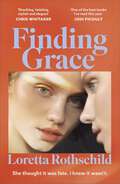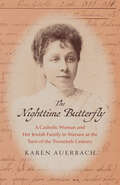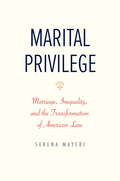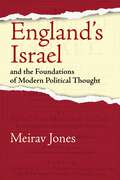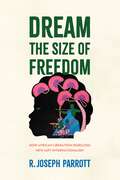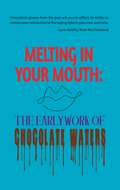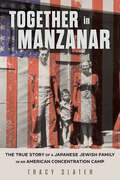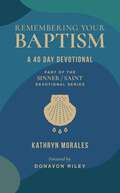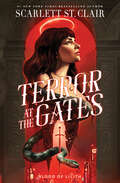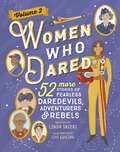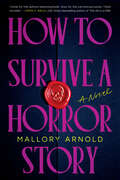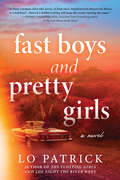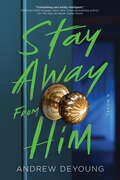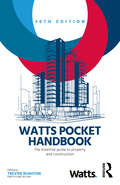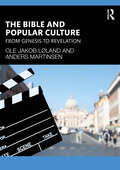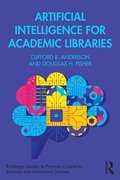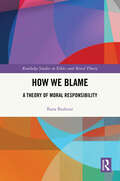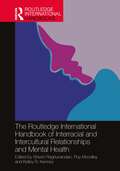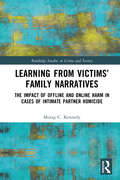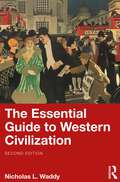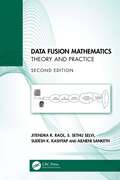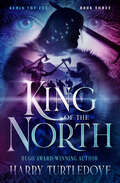- Table View
- List View
Climate: poems to celebrate change
by Whitney HansonFrom Instagram phenomenon Whitney Hanson, a revised edition of her bestselling CLIMATE, now with a new introduction and more than a dozen new poemsi don't worry about the weather anymorewhen it rains, i dancewhen the sun shines, i dancethrough it all,i will dance-from CLIMATEHonest, poignant, and relatable, Climate is a journey in embracing change both internally and externally.It guides us through all the weather we may face, from the stormy heartbreak to the foggy mental space to the sunny other side. Climate reminds us to embrace it all.The only constant in life is change, and that is a beautiful thing.Readers LOVE Whitney Hanson's poetry'This book is everything I needed and more' 5* reader review'A phenomenal writer and she portrays the truths of life so beautifully' 5* reader review'This book did wonders for my mental health and heartbreak' 5* reader review'I felt like she was talking about my own experiences' 5* reader review'Best poet out there' 5* reader review'I felt such an emotional connection to these poems' 5* reader review'Gave me literal goosebumps' 5* reader review
Finding Grace
by Loretta Rothschild'Full of wisdom and stuffed full of unpredictable twists that kept me engrossed to the end' Daily Mail'One of the best books I've read this year' Jodi PicoultSHE THOUGHT IT WAS FATE. I KNEW IT WASN'T.Honor's life is nearly perfect: she adores her bright and beautiful daughter, Chloe, and her charming, handsome husband, Tom, even if he works one hundred hours a week. Yet Honor's longing for another baby threatens to eclipse all that is wonderful - until a shocking event changes everything.Years later, Tom makes a decision that ripples through their family's life in ways he could never have predicted. As the consequences of his choice continue to unfold, two women's paths become irrevocably intwined.Blending a page-turning moral dilemma with a sweeping love story, Finding Grace explores the price of secrets and asks whether it's ever too late to tell the truth.'The darkest beach read imaginable, with a protagonist that no reader could predict' Plum Sykes, author of Wives Like Us'Shocking, stylish, elegant, and twisting. A truly stunning debut' Chris Whitaker, NYT bestselling author of All the Colours of the Dark
The Nighttime Butterfly: A Catholic Woman and Her Jewish Family in Warsaw at the Turn of the Twentieth Century
by Karen AuerbachA dynamic history of life in turn-of-the-century Warsaw through the eyes of a young woman and her Jewish family who converted to Catholicism When Alicja Lewental’s parents came of age in the middle of the nineteenth century, they believed they did not have to choose between two communities, one Polish and the other Jewish. But by the time Alicja was growing up in the 1890s, it seemed that for some Polish nationalists there was little Jews could do to be accepted unequivocally as Poles. As Alicja entered young womanhood and her father, a prominent publisher, became the target of polemics casting him as an outsider in Polish culture, her mother came to believe that only through her daughters’ conversion to Catholicism and marriage to Catholic men could their family achieve acceptance in Polish society. The Lewentals’ lives and their aspirations for belonging played out in Warsaw’s homes, salons, and bookstores in a modernizing city. Drawing on Alicja Lewental’s diary and other sources, historian Karen Auerbach provides a unique window onto how the Lewentals and their circle navigated a time of increasing ambivalence about the possibility for Jewish belonging to the Polish nation. As exclusionary notions of what it meant to be Polish gained traction in politics, Alicja and her family encountered these ideas in their private lives.
Marital Privilege: Marriage, Inequality, and the Transformation of American Law (Yale Law Library Series in Legal History and Reference)
by Serena MayeriHow the privileged legal status of marriage survived decades of constitutional struggle and social change The United States is unusual among wealthy western nations in the degree to which the law channels public benefits and private economic resources through marriage. This remains so despite seismic changes in American family life in the last several decades of the twentieth century. During this period, marriage rates declined while divorce and nonmarital childbearing soared. Social movements—for racial and economic justice, women&’s and gay rights and liberation, civil liberties, and reproductive freedom—transformed the legal landscape. In Marital Privilege, Serena Mayeri tells the stories of parents and partners, activists and lawyers who challenged the legal primacy of marriage. They made innovative constitutional claims in courts and launched grassroots efforts to change laws and practices that penalized nonmarital relationships. But even though reforms eliminated the most visible discrimination against women, people of color, and children born to unmarried parents—and, eventually, against gay and lesbian Americans—marriage&’s privileged status endured. Because marriage increasingly correlated with education and wealth, marital primacy intensified racial and economic inequality. Marital Privilege explains how, as American law selectively incorporated principles of liberty and equality, the benefits of marriage became increasingly unavailable to those who needed them most.
England’s Israel and the Foundations of Modern Political Thought (Jewish Culture and Contexts)
by Meirav JonesThe foundations of modern political thought, presumed secular, were laid in conversation with theologically motivated politics and in negotiation with Jewish ideasMid-seventeenth-century England was a hotbed in which crucial ideas of modern politics were conceived: Thomas Hobbes presented his social contract; John Selden wrote major treatises which were foundational for modern natural and international law; and England participated in the wave of republicanism that swept over Europe. This was also the period of the English Civil War—which has been portrayed as a “war of religion” and a “revolution of saints”—and was characterized by religious ends and motivations guiding politics and politicians.In England’s Israel and the Foundations of Modern Political Thought, Meirav Jones proposes that the foundational political theory conceived in this period was significantly related to the theological politics of the time. Through an examination of the language and imagery shared by theorists and saints, Jones finds that, in the twenty-year period between 1640 and1660, when Hobbes, Selden, and their contemporaries published, over 40 percent of all texts published in England contained one or more of the terms “Hebrew,” “Israel,” “Jerusalem,” “Zion,” or “Jew.” Further, all known works of political theory from the period employed these terms. While preachers in English parliament addressed and understood England as “Israel,” foundational theorists of the modern state employed ancient Israel as a political model and explicitly preferred Hebrew over Greek wisdom.Modern politics did not develop solely from within a conversation among elites, neither was it conceived as a Godless enterprise, even by its most renowned secular architects. Instead, as the book demonstrates, it spoke the language of religiously motivated politics and was conceived in its terms. Ultimately, Jones argues that it was through a sweeping revival of Hebrew in early modern Europe that the foundations of modern politics were laid in conversation with theological politics and in negotiation with Jewish ideas and ideas of the Jews.
Dream the Size of Freedom: How African Liberation Mobilized New Left Internationalism (Power, Politics, and the World)
by R. Joseph ParrottHow anti-colonial movements in Angola, Mozambique, and Guinea-Bissau reshaped US activist engagement with the Global South from the 1960s through the 1970sDream the Size of Freedom explores how anti-colonial movements in Angola, Mozambique, and Guinea-Bissau reshaped US activist engagement with the Global South from the 1960s through the 1970s and influenced American foreign policy as the Vietnam War drew to a close. These Portuguese African liberation movements, led by nationalists like Eduardo Mondlane and Amílcar Cabral, built global solidarity networks to support their military and social challenges to empire while defending against Western intervention. US activists disillusioned with the Cold War came to see African self-determination as central to global campaigns for racial and economic justice. A broad coalition ranging from Black Power radicals to religious liberals mobilized against the North Atlantic alliance with Portugal. In the process, this grassroots movement helped define a New Left Internationalism that championed decentralized, multiracial organizing and a collaborative vision of US foreign policy to redress historic inequalities between Global North and South.Drawing on more than fifty oral histories and research in government and activist archives on three continents in English, Portuguese, French, and Afrikaans, R. Joseph Parrott reconstructs the transnational anti-imperial network that injected Global South priorities into US political debates. Popular protests and informational campaigns led to collaborations with legislators eager to constrain the powerful executive branch. In 1976, this grassroots-legislative alliance halted Gerald Ford’s anti-communist intervention against the Soviet-backed government of newly independent Angola. This victory of New Left Internationalist ideas anticipated future anti-apartheid and Latin American peace movements while also fueling a conservative revival of Cold War containment. By exploring US engagement with the contested process of African decolonization, Dream the Size of Freedom highlights the origins of two contrasting visions of American foreign policy that defined debates over the country’s proper role in the Global South into the 1990s.
Melting in Your Mouth: The Early Work (Sapphic Classic)
by Chocolate WatersThe best of Chocolate Waters' poetry finds its home in Melting in Your Mouth: The Early Work of Chocolate Waters. During the Women's Liberation Movement, Waters traveled around the United States to share her erotic, angry, and feminine poems, gathering throngs of lesbian admirers. Waters was a modern-day lesbian-feminist bard performing her poems with theatrical flair. Waters' poems grapple with gender norms, sexual harassment, and hetero-patriarchal publishing expressing the rage that comes with experiencing the second-class citizenry of womanhood. Even more radical, Waters' writes of lesbian intimacy and sex, calling attention to nuances of family and belonging in the context of her identity as a lesbian.Melting in Your Mouth is a treasury of Waters' early work. As witness to and participation in Gay Liberation and the Women's Liberation Movement of the seventies and eighties, Waters' poems also witness a genealogy of living and laughing authentically against all odds.
Together in Manzanar: The True Story of a Japanese Jewish Family in an American Concentration Camp
by Tracy SlaterOn a late March morning in the spring of 1942, Elaine Yoneda awoke to a series of terrible choices: between her family and freedom, her country and conscience, and her son and daughter. She was the child of Russian Jewish immigrants and the wife of a Japanese American man. On this war-torn morning, she was also a mother desperate to keep her young mixed-race son from being sent to a US concentration camp. Manzanar, near Death Valley, was one of ten detention centers where our government would eventually imprison every person of Japanese descent along the West Coast—alien and citizen, old and young, healthy and sick—or, in the words of one official, anyone with even "one drop" of Japanese blood. Elaine's husband Karl was already in Manzanar, but he planned to enlist as soon as the US Army would take him. The Yonedas were prominent labor and antifascist activists, and Karl was committed to fighting for what they had long cherished: equality, freedom, and democracy. Yet when Karl went to war, their son Tommy, three years old and chronically ill, would be left alone in Manzanar—unless Elaine convinced the US government to imprison her as well. The consequences of Elaine's choice did not end there: if she somehow found a way to force herself behind barbed wire with her husband and son, she would leave behind her white daughter from a previous marriage. Together in Manzanar tells the story of these painful choices and conflicting loyalties, the upheaval and violence that followed, and the Yonedas' quest to survive with their children's lives intact and their family safe and whole.
Remembering Your Baptism: A 40-Day Devotional
by Donavon Riley Kathryn MoralesThe act of creation took place over six days, culminating in God's rest from his work on the seventh day. Each week, therefore, serves as a reminder of God's work of creation. The opening chapters of Genesis set the stage for our pattern of seven-day weeks. In Remembering Your Baptism: A 40-Day Devotional, each week is made up of eight days. The eighth day is the day of our Lord's resurrection. It is the new day of everlasting rest. In baptism, God is at work through water and his Word delivering these gifts of life, forgiveness, and salvation. Anchored in watery Scripture accounts, this devotional dives into the comfort and promises gifted in baptism through forty unique devotions. Through devotions on creation, the flood, Jesus' baptism, the Psalms, and more, you will be reminded of the work of Jesus given to you through the gift of Holy Baptism. Each devotion includes an opening Scripture passage, devotion, closing prayer, and suggested Scripture reading for further reflection. Each devotion explores the work of the Father, Son, and Holy Spirit in baptism. Following the forty devotions is an appendix of baptismal resources which includes prayers and baptismal questions with answers.
Terror at the Gates (Blood of Lilith #1)
by Scarlett St. ClairThe first in a seductive new romantasy series from #1 New York Times bestselling author Scarlett St. Clair. Banished and betrayed, Lilith rises from the shadows of her past to claim forbidden power—and a destiny written in blood and desire.She is the beginning and the end.She is peace and chaos.She is terror knocking at the gates.Estranged from her powerful family, Lilith Leviathan finds refuge in Nineveh, a district in the city of Eden devoted to sin. There, she uses her magic to steal for a living, attracting the attention of the five governing families as well as the church, which expects women to remain pious and silent. When Lilith comes into possession of a beautiful blade, she thinks all her worries are over…until her usual buyer dies while inspecting it.Frantic, Lilith turns to the only man who can help her: Zahariev, head of the Zareth family and ruler of Nineveh. His currency is information, and his power is extortion, though he's always had a soft spot for Lilith. But when the dagger appears, he isn't sure he can protect her from what's to come.Together, they embark on a mission to discover the true power running their world. As their lives intertwine, Lilith realizes Zahariev is more than just a friend, but their devotion to each other is a threat—to the truth, to the church, and to those who want to tear it all down.Perfect for fans of:Frenemies to loversSlow burn, but the sexual tension is...toe-curlingHe falls firstNeo-noir mafia fantasy vibes"In this sumptuous and steamy dark fantasy, bestseller St. Clair reimagines Eden as an intensely patriarchal, über-religious society... Determined to make her own way, (Lilith) relies on her power over men's desire to steal the things she needs—but, for some reason, gorgeous Zahariev is constantly in her path and swooping in to clean up her messes... A promising series launch." - Publishers Weekly
Women Who Dared Volume 2: 52 More Stories of Fearless Daredevils, Adventurers, and Rebels (Women Who Dared)
by Linda SkeersWomen Who Dared Volume 2 brings readers 52 MORE incredible stories of daredevils and adventurers from around the world for readers of all ages. Celebrate and be inspired by the amazing, outrageous stories of women!Women have been doing amazing, daring, and dangerous things for years, yet they're rarely mentioned in our history books as adventurers. This sequel of short biographies features women throughout history who have risked their lives for adventure—some of whom you may know, many of whom you may not know, but all of whom you'll WANT to know, like:Katherine Cheung, the first Chinese woman to obtain an international flying licenseLaura Dekker, the youngest person to sail around the world single-handedlyKatharina Paulus, an exhibition parachute jumper and the inventor of the first collapsible parachute
How to Survive a Horror Story: A Novel
by Mallory ArnoldSeven authors enter the manorCan they survive the story within?When legendary horror author Mortimer Queen passes, a group of writers find themselves invited to his last will and testament reading expecting a piece of his massive fortune. Each have their own unique connection to the literary icon, some known, some soon to be discovered, and they've been waiting for their chance to step into the author's shoes for some time.Instead, they arrive at his grand manor and are invited to play a game. The rules are simple, solve the riddle and progress to the next room. If they don't, the manor will take one of them for itself.You see, the Queen estate was built on the bones of Mortimer's family, and like any true horror story, the house is still very, very hungry.With the clever, locked-room thrills of Everyone in My Family Has Killed Someone with the ghostly horror of The Fall of the House of Usher, How to Survive a Horror Story is a bright, biting, thrill-ride that begs us to contemplate how the best horror stories come to be.
Fast Boys and Pretty Girls: A Novel
by Lo PatrickThey say you can never go home again. And sometimes, you shouldn't.Following a semi-successful career as a teen model in New York City, Danielle Greer has moved back to the mountains of North Georgia and is living in her childhood home with her husband and four daughters. One stifling, lazy afternoon, the girls are exploring the ravine behind the house when they come across a body.Danielle knows the body doesn't belong to Benji Law, a younger local misfit who Danielle had an illicit relationship with as a teenager. No, his body was found right away, after he was killed in a motorcycle accident on the road in front of her family's house. Danielle has a good idea who the body might be, but she doesn't know how it got there.When local police officer Cady Benson is called in to investigate, Danielle's world is turned upside down, and she's thrust back into those dark, confusing days leading up to Benji's death, battling the things she remembers with the things she can't forget.From the acclaimed author of The Floating Girls and The Night the River Wept comes a gritty, coming-of-age, slow-burn Southern mystery with devastating characters and a twist that will leave you aching, exposing the all-consuming, obsessive power of first love and what it can do to a person.
Stay Away from Him
by Andrew DeYoung"Had me hooked from the first line. The characters are complex in a way that makes it impossible to tell who to trust." —Tasha Coryell, author of Love Letters to a Serial KillerOn the evening she met exonerated murderer Thomas Danver, Melissa Burke let him help put her five-year-old son to bed before coming back upstairs to enjoy the dinner party. Thomas was so nice, and a pediatrician. She didn't know anything then about his wife's suspicious death...Relocating with her 5-year-old son to a new city after an ugly divorce, Melissa Burke isn't looking for a new relationship right away—only distance from her ex, and space to rest and heal from the emotional scars of a broken marriage. But an unexpected relationship is exactly what she finds at a friend's dinner party when she meets Thomas Danver, a charming widower who asks for her number at the end of the night. Intrigued, Melissa learns from her neighbors that Thomas is a dedicated father of two girls, one of the most respected pediatricians in the city—and an exonerated murderer.Thomas's first wife went missing three years ago, presumed dead, and Thomas was eventually cleared of her murder in an investigation that became a local media sensation. But while some still believe he killed his wife, Melissa's friends insist that he was unfairly targeted by the police and couldn't hurt a fly. Attracted to Thomas and also fascinated by the case, Melissa agrees to one date—and finds herself quickly swept into an obsessive, whirlwind romance.But when Melissa receives a chilling, anonymous threat—or perhaps it's a warning—she begins to question how much she truly knows about the man she's falling in love with. Is he really innocent?"A powerful, cautionary thriller."—William Kent Krueger, New York Times bestselling author, for The Day He Never Came Home
Watts Pocket Handbook: The Essential Guide to Property and Construction
by Trevor RushtonThis milestone 30th edition of the Watts Pocket Handbook has had a thorough overhaul and renews its commitment to share industry knowledge by providing technical and legal information across a comprehensive spread of property and construction topics.The Handbook provides specialist information and guidance on a vast selection of related subjects including: Environmental and sustainability issues; Contracts and procurement; Design and construction; Health and safety; Regulations and standards; Legal issues and insurance; Facilities management; Materials and defects; and Technology, innovation and the future. Watts Pocket Handbook remains the must-have reference book for professionals and students engaged in construction, building surveying, services engineering, architecture, project management, facilities management, quantity surveying, property development and much more.
The Bible and Popular Culture: From Genesis to Revelation
by Ole Jakob Løland Anders MartinsenThis book is an accessible overview of the Bible’s complex and evolving reception in popular culture. Drawing on biblical interpretations in TV, film, and music, it demonstrates the enduring diversity of the Bible’s reception history.Ranging from Genesis and Exodus of the Hebrew Bible to the Gospels and Revelation of the New Testament, its biblical chronology takes a book-by-book format that locates and examines various examples of how these texts have been read, received, and interpreted. Case studies include The Handmaid's Tale, Exodus: Gods and Kings, The Da Vinci Code, and Family Guy. Woven within these chapters is fresh analysis of how themes of parody, satire, sex, and conspiracy appear in these biblical interpretations.This book is an engaging resource for students encountering biblical reception history in popular culture for the first time, and it will also be of wider interest to those intrigued by the interplay between religion, culture, and media.
Artificial Intelligence for Academic Libraries (Routledge Guides to Practice in Libraries, Archives and Information Science)
by Clifford B. Anderson Douglas H. FisherArtificial Intelligence for Academic Libraries provides a clear and dependable guide to the history, theory, and application of artificial intelligence (AI) and machine learning (ML) in academic libraries, addressing the needs of librarians, staff, administrators, and other stakeholders. Emerging from a long-running conversation between an academic librarian and a professor of computer science, this book provides readers with a critical perspective on the history, present, and future of AI in libraries and information services. Synthesizing the literature on AI, ML, and librarianship, the authors provide the requisite background to evaluate the impact of these technologies on the information ecosystem. The first half of the volume covers the fundamentals of AI, notably the divergences between the two major AI paradigms as well as philosophical, legal, and ethical issues that arise from the use of AI. The second half addresses specialized topics, including hybrid AIs that bridge the dominant AI paradigms, the responsible use of AI in research and learning, and suggestions for professional development. Artificial Intelligence for Academic Libraries will benefit academic librarians seeking to develop a solid understanding of AI and ML and their likely impact on library operations and services, including student and faculty outreach. The volume also serves as a pedagogical resource for library and information science students entering this rapidly changing field.
How We Blame: A Theory of Moral Responsibility (Routledge Studies in Ethics and Moral Theory)
by Bana BashourThis book presents a naturalistic account of moral responsibility that is neutral on the metaphysics of free will. It engages with empirical literature in experimental philosophy and psychology and draws on real-life case studies to illuminate the author’s theory of moral responsibility. The author argues that agency requires an understanding of moral responsibility attributions, which requires that one understands one’s intentional states and those of others. Further, she argues that a justified attribution of moral responsibility involves justified attributions of intentional states and justified perceptions of norm violations. This claim is novel because when moral responsibility is indexed to a particular onlooker, the discussion becomes one about whether a blamer is justified in attributing moral responsibility to the blamed. Another distinctive feature of the author’s account is that it makes room for cultural variability in our justifications of moral responsibility; those in different cultures may have different norms or expectations of one another. The first part of the book argues for a theoretical account of agency and moral responsibility while making distinctions between those and one’s theory of punishment. While justified attributions are interpersonal, theories of punishment are institutional and societal in nature. The second part of the book goes into the literature from empirical psychology and experimental philosophy on the nature of moral responsibility. How We Blame will appeal to philosophers and psychologists interested in the issue of moral responsibility.
The Routledge International Handbook of Interracial and Intercultural Relationships and Mental Health (Routledge International Handbooks)
by Roy Moodley Shivon Raghunandan Kelley R. KenneyThe Routledge International Handbook of Interracial and Intercultural Relationships and Mental Health presents critical, theoretical, empirical, and psychological accounts of intercultural intimacies.It challenges pervasive Eurocentric discourse and ideas and offers current, scholarly, practical, equitable, global, and intercultural responsive philosophies, theories, clinical frameworks, and practices. The chapters in this text offer critical perspectives on the mental health and well‑being of intercultural couples, inclusive of multi‑cultural, multi‑ethnic, multi‑faith, multi‑sexual, multi‑racial, multi‑gendered, multi‑abled couples, and their intersections. A diverse range of international contributors present an intersectional analysis of traditional and contemporary cultural ideas and relationship philosophies and explore multiple global and cultural psychologies that shape the health and well‑being of intercultural couples and their families.This handbook is essential for students, educators, mental health clinicians, and researchers in counselling, psychotherapy, clinical psychology, psychiatry, and social work programmes.
Smart Sensors: Design, Challenges, and Applications
by Praveen Kumar Malik Manoj Kumar Shukla Anuj Jain Neeraj Kumar MishraThe reference text comprehensively discusses micro-electromechanical systems and nanoelectromechanical systems-based design of smart sensors, fabrication techniques for smart sensors, and smart wearable stress monitoring devices for autistic children. It covers applications of smart sensors in diverse areas including medical, agricultural, space, automobiles, manufacturing, security, and surveillance. This book: Discuss design parameters of micro-electromechanical systems and nanoelectromechanical systems-based smart sensors. Covers smart sensors for conditioning and monitoring of electrical machines, robotic systems, and electric vehicles. Highlights the importance of using smart sensors in localization, navigation, and mapping. Explains efficient mobile Ad-hoc network using predictive link sustainability model, and smart sensor technologies for the Internet of Things applications. Illustrates the graded node deployment with improved M-LEACH protocol to increase the lifetime of wireless sensor networks. It is primarily written for senior undergraduates, graduate students, and academic researchers in the fields of electrical engineering, electronics and communications engineering, sensor technology, nanoscience, and nanotechnology.
Learning from Victims’ Family Narratives: The Impact of Offline and Online Harm in Cases of Intimate Partner Homicide (Routledge Studies in Crime and Society)
by Morag C. KennedyOffering a new perspective on intimate partner abuse and homicide, this book recognises the families of victims as legitimate agents of knowledge in terms of the harm experienced by their family members, and considers how this harm is extended to the families themselves.Examining harm from both an offline and online point of view, the book explains the multipurpose roles of offline and online harm and how these roles do not occur in isolation in terms of the victims’ and families’ abusive experiences. In doing so, it demonstrates the range of harm experienced in the context of intimate partner abuse and homicide, and outlines the overlapping nature of offline and online harm without prioritising one form of harm over the other; instead, considering the harm experienced as a continuum.Providing theoretical and empirical contributions that are largely absent from existing victimology and harm literature, Learning from Victims’ Family Narratives: The Impact of Offline and Online Harm in Cases of Intimate Partner Homicide will be of interest to scholars, researchers, students, and practitioners exploring the modern conceptualisation of harm and its impact on individuals beyond the victim and perpetrator
Making Sense of Epidemiological Research: A Student's Guide
by Katherine W. ReevesUsing clear language and real-world examples, this accessible textbook provides a concise guide to the understanding and critical evaluation of journal articles in epidemiology.The book offers a step-by-step process, beginning with how to find epidemiologic studies on a given topic. It then shows readers how to identify and assess the key features of a study’s design, the methods of data collection and analysis, the conclusions that can be drawn, and finally the questions that remain. Including a chapter exploring the misuse of artificial intelligence, this complete companion shows students not only how to evaluate individual studies but also to synthesize findings across multiple studies on a single topic, as well as guidance on writing a critique of a given article.Written by an experienced instructor with over 15 years of experience teaching, and including activities so that readers can practice the skills they learn, this will be essential reading for any student of epidemiology, public health, and medicine.
The Essential Guide to Western Civilization
by Nicholas L. WaddyThis new edition of The Essential Guide to Western Civilization provides a succinct and engaging overview of European history for students.With wide chronological coverage, from early humans and the first civilizations to the present, this book provides a narrative of key events in the West with insightful analysis to further contextualize the relationship of the West to the wider world. The second edition has been fully updated, with increased coverage of women, slavery, colonization, economics and finance, and concurrent developments in the non-Western world. It engages with recent scholarship and includes updated suggested readings to offer a more comprehensive view of Western Civilization. To further aid student understanding, this book includes review questions at the end of each section, key terms and definitions for each chapter, discussion questions at the end of every chapter, and maps and images to illustrate important concepts.Ideal for undergraduates in Western Civilization and European history courses, this volume is a concise, accessible resource that encourages students to think critically and creatively about history.
Data Fusion Mathematics: Theory and Practice
by Jitendra R. Raol Sudesh K. Kashyap S. Sethu Selvi Ailneni SankethData Fusion Mathematics: Theory and Practice offers a comprehensive overview of data fusion (DF) and provides a proper and adequate understanding of the basic mathematics directly related to DF.This new edition offers updated chapters alongside four new chapters that are based on recent research carried out by the authors, including topics on machine learning techniques, target localization using a network of 2D ground radar, thermal imaging sensors for multi‑target angle‑only tracking, and multi‑sensor data fusion for a single platform and team platforms. This book also covers major mathematical expressions, formulae and equations, and, where feasible, their derivations. It discusses signed distance function concepts, DF models and architectures, aspects and methods of types 1 and 2 fuzzy logics, and related practical applications. In addition, the authors cover soft computing paradigms that are finding increasing applications in multi-sensory DF approaches and applications.This text is geared toward researchers, scientists, teachers, and practicing engineers interested in and working in the multi‑sensor data fusion area.
King of the North (Gerin the Fox)
by Harry TurtledoveThe award-winning author continues the epic fantasy series that began with Werenight and Prince of the North as a bold warrior comes into his own.Though he has taken the reins of power in the North, Gerin the Fox has no time to enjoy his victory. The gods reveal to him that a grave danger is approaching. Now he must face a new enemy, the Gradi, a people who follow ruthless gods. The Gradi not only conquer lands, but destroy them so completely as to render them uninhabitable. To stop this menace and truly be King of the Northlands, Gerin will have to make uncomfortable alliances . . . and survive a war of gods.

